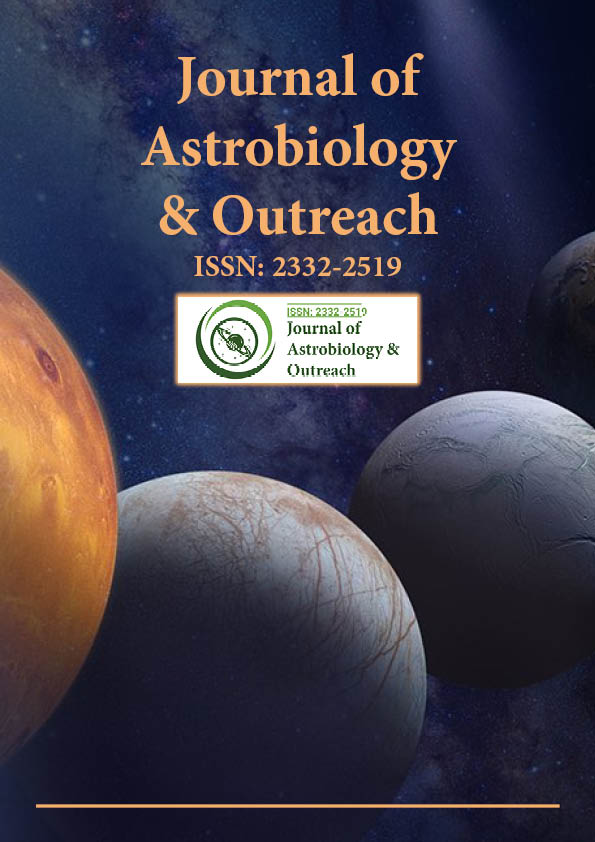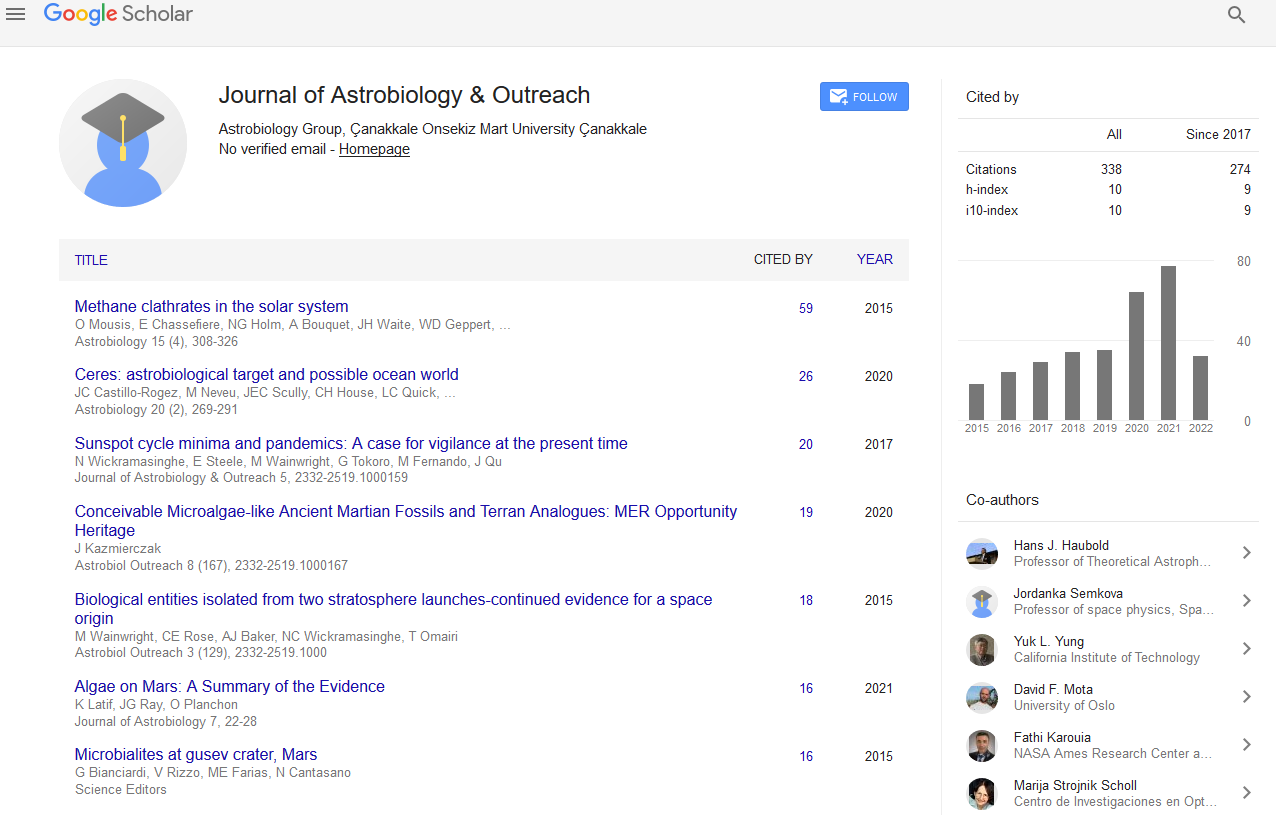Indexed In
- Open J Gate
- Academic Keys
- JournalTOCs
- RefSeek
- Hamdard University
- EBSCO A-Z
- OCLC- WorldCat
- Google Scholar
Useful Links
Share This Page
Journal Flyer

Open Access Journals
- Agri and Aquaculture
- Biochemistry
- Bioinformatics & Systems Biology
- Business & Management
- Chemistry
- Clinical Sciences
- Engineering
- Food & Nutrition
- General Science
- Genetics & Molecular Biology
- Immunology & Microbiology
- Medical Sciences
- Neuroscience & Psychology
- Nursing & Health Care
- Pharmaceutical Sciences
Perspective - (2024) Volume 12, Issue 2
Preserving Natural Nightscapes through the Dark Sky Program
Emily Smith*Received: 28-May-2024, Manuscript No. JAO-24-27366; Editor assigned: 31-May-2024, Pre QC No. JAO-24-27366 (PQ); Reviewed: 14-Jun-2024, QC No. JAO-24-27366; Revised: 21-Jun-2024, Manuscript No. JAO-24-27366 (R); Published: 28-Jun-2024, DOI: 10.35248/2332-2519.24.12.345
Description
The Dark Sky Program is a global initiative focused on preserving and restoring dark skies, emphasizing the significance of natural nightscapes for both astronomical observation and environmental health. With light pollution increasing in urbanized areas worldwide, it becomes increasingly challenging to observe celestial bodies without interference from artificial light. This interference affects not only professional astronomy but also public appreciation and access to the night sky. The Dark Sky Program collaborates with various astronomy groups, governments and communities to address these concerns through education, policy and innovative lighting solutions. Artificial light at night, when uncontrolled, contributes to skyglow a brightening of the night sky caused by excessive outdoor lighting. Skyglow reduces visibility of stars and other celestial bodies, making stargazing, amateur astronomy and even professional observations difficult in or near urban areas. As light from cities and towns scatters in the atmosphere, it creates a veil over the night sky, diminishing the contrast necessary for observing faint celestial objects. This situation has led many observatories to establish operations in remote areas or mountaintop locations to avoid the worst effects of light pollution. However, even these remote sites are not immune as urban areas expand.
The Dark Sky Program encourages the use of “dark-sky friendly” lighting, which reduces skyglow by limiting the amount of light that escapes upward. Implementing such lighting in residential and commercial areas can minimize artificial light spillage, reducing the impact on local night skies. Shielded outdoor lighting, reduced wattage and motion-sensitive lights are effective strategies promoted by the Dark Sky Program to minimize unnecessary illumination. These measures contribute to a clearer night sky, benefiting not only professional astronomers but also local residents who can more easily observe celestial events and enjoy a connection to the natural environment. Beyond its effects on astronomy, excessive artificial light disrupts ecosystems. Nocturnal animals rely on natural light cycles for migration, reproduction and foraging and artificial light interferes with these behaviors. For example, sea turtle hatchlings navigate toward the ocean by following the natural light of the horizon. In artificially lit coastal areas, however, these hatchlings can become disoriented, moving inland rather than toward the water, putting their survival at risk. Migratory birds, which often rely on the stars for navigation, can also be affected, losing their sense of direction in brightly lit urban areas. By reducing light pollution, the Dark Sky Program indirectly helps preserve these natural behaviors and protects biodiversity.
The program’s initiatives extend to public education, where communities are encouraged to engage with their local night skies. Dark sky parks and reserves, designated by the International Dark-Sky Association (IDA), provide protected areas with minimal artificial lighting, allowing visitors to experience unpolluted night skies. These sites offer educational programs, guided stargazing sessions and other resources that emphasize the value of natural nightscapes. By establishing these reserves, the Dark Sky Program raises awareness about the importance of dark skies for both scientific and cultural reasons. Communities that have embraced dark sky practices often report an increase in local tourism, as people come to enjoy clear, starfilled skies rarely visible in urban settings. The Dark Sky Program also addresses the issue of light pollution through legislative advocacy, promoting policies that regulate outdoor lighting standards. By establishing guidelines on acceptable light levels, types of fixtures and curfews for non-essential lighting, policymakers can support efforts to reduce light pollution. Cities such as Tucson, Arizona and Flagstaff, Arizona both known for their proximity to major observatories have implemented strict lighting ordinances that serve as models for other communities. These regulations not only aid in light pollution reduction but also lower energy consumption, which has environmental and economic benefits. As more cities adopt dark-sky policies, the program’s efforts gain traction, promoting broader change. Technology continues to play an essential role in dark sky efforts, as innovations in lighting and data collection aid in monitoring and controlling light pollution. Devices that measure sky brightness can provide data on pollution levels in real time, helping communities understand the effectiveness of their dark-sky initiatives. Additionally, smart lighting systems can adapt to the surrounding environment, reducing light output during lowtraffic periods or adjusting brightness according to weather conditions. These technological advancements align with the goals of the Dark Sky Program, offering practical solutions to maintain nighttime visibility and reduce environmental impact.
The future of the Dark Sky Program relies on continued collaboration between scientists, policymakers, communities and individuals committed to preserving the natural nightscape. While the challenge of light pollution is ongoing, awareness and education are critical. By demonstrating the benefits of reduced artificial lighting on human health, wildlife and the economy, the program gains broader support, encouraging more communities to adopt dark-sky practices. Ultimately, the vision of the Dark Sky Program is to restore the night sky as a shared resource, preserving it for generations to come and allowing people to experience the beauty and wonder of an unpolluted night sky.
Citation: Smith E (2024). Preserving Natural Nightscapes through the Dark Sky Program. J Astrobiol Outreach. 12:345.
Copyright: © 2024 Smith E. This is an open-access article distributed under the terms of the Creative Commons Attribution License, which permits unrestricted use, distribution, and reproduction in any medium, provided the original author and source are credited.

